bulb PORSCHE 944 1987 1.G Owners Manual
[x] Cancel search | Manufacturer: PORSCHE, Model Year: 1987, Model line: 944, Model: PORSCHE 944 1987 1.GPages: 66, PDF Size: 3.3 MB
Page 3 of 66

INDEX
A
ABS Acceleration diagram Accelerator pedal Air Bag System Air - cleaner
- conditioner
- filter
Alternator warning light Antifreeze Antilock, Brake system Anti-theft alarm Ashtray Automatic- garage door
- speed control
- transmission
- transmission fluid B
Battery
Boost pressure gauge
Brake - booster
- fluid
- fluid warning light
- pads
- parking
- pedal
- system
- warning light
Break-in hints
Bulb replacing
Buzzer 28,39
118-129
55
20, 21, 38, 3980, 8144-4680,81 39
74,75,11028, 39
11
42, 98
25
29
53-55
78,110,128
90-9234
27
39,79,11039
27,37,47,79,80 26
26, 27
26,27,11537
47
93-98
10,18,24,30
C/D
CASIS
Capacities
Car care instructions
Casis
Catalytic Converter
Cautions
Central locking
Central warning light
Cigarette lighter
Cleaning
Clock
Clutch pedal
Collapsible spare tire
Control warning light system
Coolant Temperature Gauge
Cooling system
Corrosion prevention
Dashboard
Defogging/defrosting
Dimensions
Doors
Driving hints
E/F
Electrical system
Emergency- flasher
- starting
Emission Control System
Engine - cooling
- exhaust
- hood
- number
- oil checking & changing
- oil
-speed, max 35
110
61-66
35
50,10267
13
37
41
61-66 40
27
85
36-39 36
74-77
65-66
24
44-46 114
12,138-9, 48, 49
89-92
41
92
100-103 74-77
48
586
69-72
69,110,111,128
34,47,52,106-
108
Fan control switch knob
Fan, radiator
Filling capacities
Fog lights
Fuel - economy
- evaporation control
- gauge
- recommendation
- tank
Fuses and relays
G/H
Gas Station Information
Gasohol
Gasoline
Gear ratio diagram
Gearshift lever
Glove compartment
Hatchback
Headlights
Headlight- dimmer
- flasher
- switch
- washing system
Heater/ventilation controls
Hood - front
- rear
Horn
I/J
Ignition/steering lock
Instrument illumination
Instruments
Interior ligh 44
36, 74 110
30, 96, 97
49
103 37
50, 51
50,110
89,126
126-129 51
50,51
122-125 52-55
42
56
30,95,99 30
30
30
31,32,81,11044-4658
56,57
21,24
24
30
33-40
43, 98
4
Jack
- supports
K/L
Keys
Kickdown
Lane changer
Leather
License plate light
Light switch
Lights - ashtray
- fog
- interior
- license plate
- parking
- turn signal
Locks - doors, wheels
Loudspeakers
Lubricants
Luggage compartment
M/O
Manual transmission
- oil
Mirrors
Oil- change
- consumption
- filter changing
- pressure gauge
- pressure warning light
Octane rating
Oxygen Sensor
P/R
Paint code number 68
87, 88, 129
10-11,86 55
30
65
98
30
98
30, 96, 97
43, 9898
30, 37, 93, 94
30,93,94
10-13, 86 89
110,111 57
52,122-125 77,11022,43
71,72
47, 69
71, 72 38
38
50, 51,106-108 101,102
7
Parking- brake
- lights
Performance
Power assisted steering
Power train
Power windows
Prop-up roof
Radiator fan
Rear - hood
- view mirrors
- window defogger
- wiper
Recirculation Switch
Refrigerant
Relays
Rims
Roof racks
Roof, removable S
Safe driving hints
Safetybelts
Safety belt warning light
Safety compliance sticker
Seat heating System
Seats
Sekuriflex windshield
Shift indicator
Shift points
Side marker lights
Ski racks
Snow- chains
- tires
Spare tire, collapsible
Spark plugs
Specifications, engine
26, 3730,37,93,94116731091259, 6036, 7456,572241424446,11089,12664,112,11357,11459, 60
8-9
17-21,6518,3771514-1631, 63, 643552-559457,11483, 84,112,113
83,84, 111,113
85106-108106-109
Speedometer
Starting procedures
Sun visors
T/U
Tachometer
Technical data
Tirepressure
Tires
Tool kit
Trip odometer
Transmission oil
Trunk
Turn signal lights
Undercoating
Unleaded fuel
V/W
Vehicle identification
Ventilation
Voltmeter
Warning/indicator lights
Washer reservoir
Washing
Water temperature gauge
Weatherstrips
Weights
Wheel alignment
Wheel nuts, lockable
Wheels
Wheel changing
Windows
Windshield- washer reservoir
- wiper/washer lever 3324, 2543
34, 35105-12582,112,113,12947,82-87,112,113683377, 78,11056,5730, 37, 93, 9465, 66,10050, 51,106-108,110
6-744-463835-4081,11061-6636641141158647,64,82-87,11285-8812,63,6481,11031
5
Page 6 of 66
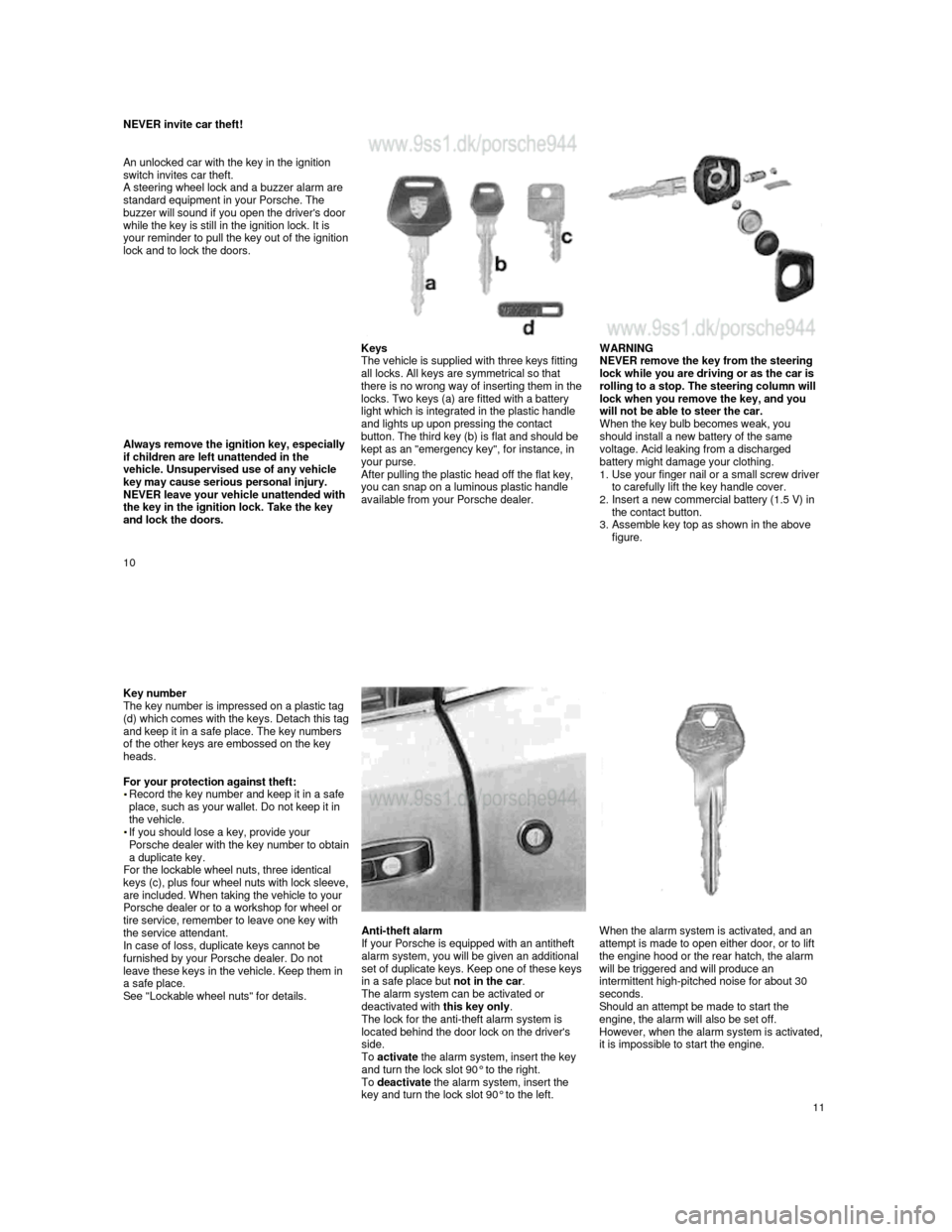
NEVER invite car theft! An unlocked car with the key in the ignition switch invites car theft. A steering wheel lock and a buzzer alarm are standard equipment in your Porsche. The
buzzer will sound if you open the driver's door
while the key is still in the ignition lock. It is your reminder to pull the key out of the ignition lock and to lock the doors.
Always remove the ignition key, especially
if children are left unattended in the
vehicle. Unsupervised use of any vehicle
key may cause serious personal injury.
NEVER leave your vehicle unattended with
the key in the ignition lock. Take the key
and lock the doors.
Keys
The vehicle is supplied with three keys fitting
all locks. All keys are symmetrical so that
there is no wrong way of inserting them in the
locks. Two keys (a) are fitted with a battery
light which is integrated in the plastic handle
and lights up upon pressing the contact
button. The third key (b) is flat and should be
kept as an "emergency key", for instance, in
your purse.
After pulling the plastic head off the flat key, you can snap on a luminous plastic handle
available from your Porsche dealer.
WARNING NEVER remove the key from the steering
lock while you are driving or as the car is
rolling to a stop. The steering column will
lock when you remove the key, and you
will not be able to steer the car.
When the key bulb becomes weak, you
should install a new battery of the same
voltage. Acid leaking from a discharged
battery might damage your clothing.
1.
Use your finger nail or a small screw driver
to carefully lift the key handle cover.
2.
Insert a new commercial battery (1.5 V) in
the contact button.
3.
Assemble key top as shown in the above figure.
10
Key number
The key number is impressed on a plastic tag
(d) which comes with the keys. Detach this tag and keep it in a safe place. The key numbers
of the other keys are embossed on the key
heads.
For your protection against theft:
Record the key number and keep it in a safe
place, such as your wallet. Do not keep it in
the vehicle.
If you should lose a key, provide your Porsche dealer with the key number to obtain a duplicate key.
For the lockable wheel nuts, three identical
keys (c), plus four wheel nuts with lock slee
ve, are included. When taking the vehicle to your
Porsche dealer or to a workshop for wheel or
tire service, remember to leave one key with
the service attendant.
In case of loss, duplicate keys cannot be
furnished by your Porsche dealer. Do not
leave these keys in the vehicle. Keep them in
a safe place.
See "Lockable wheel nuts" for details.
Anti-theft alarm
If your Porsche is equipped with an antitheft
alarm system, you will be given an additional
set of duplicate keys. Keep one of these keys
in a safe place but not in the car.
The alarm system can be activated or
deactivated with this key only.
The lock for the anti-theft alarm system is
located behind the door lock on the driver's
side.
To activate the alarm system, insert the key
and turn the lock slot 90° to the right.
To deactivate the alarm system, insert the
key and turn the lock slot 90° to the left.
When the alarm system is activated, and an
attempt is made to open either door, or to lift
the engine hood or the rear hatch, the alarm
will be triggered and will produce an intermittent high-pitched noise for about 30
seconds.
Should an attempt be made to start the
engine, the alarm will also be set off.
However, when the alarm system is activated, it is impossible to start the engine.
11
Page 13 of 66
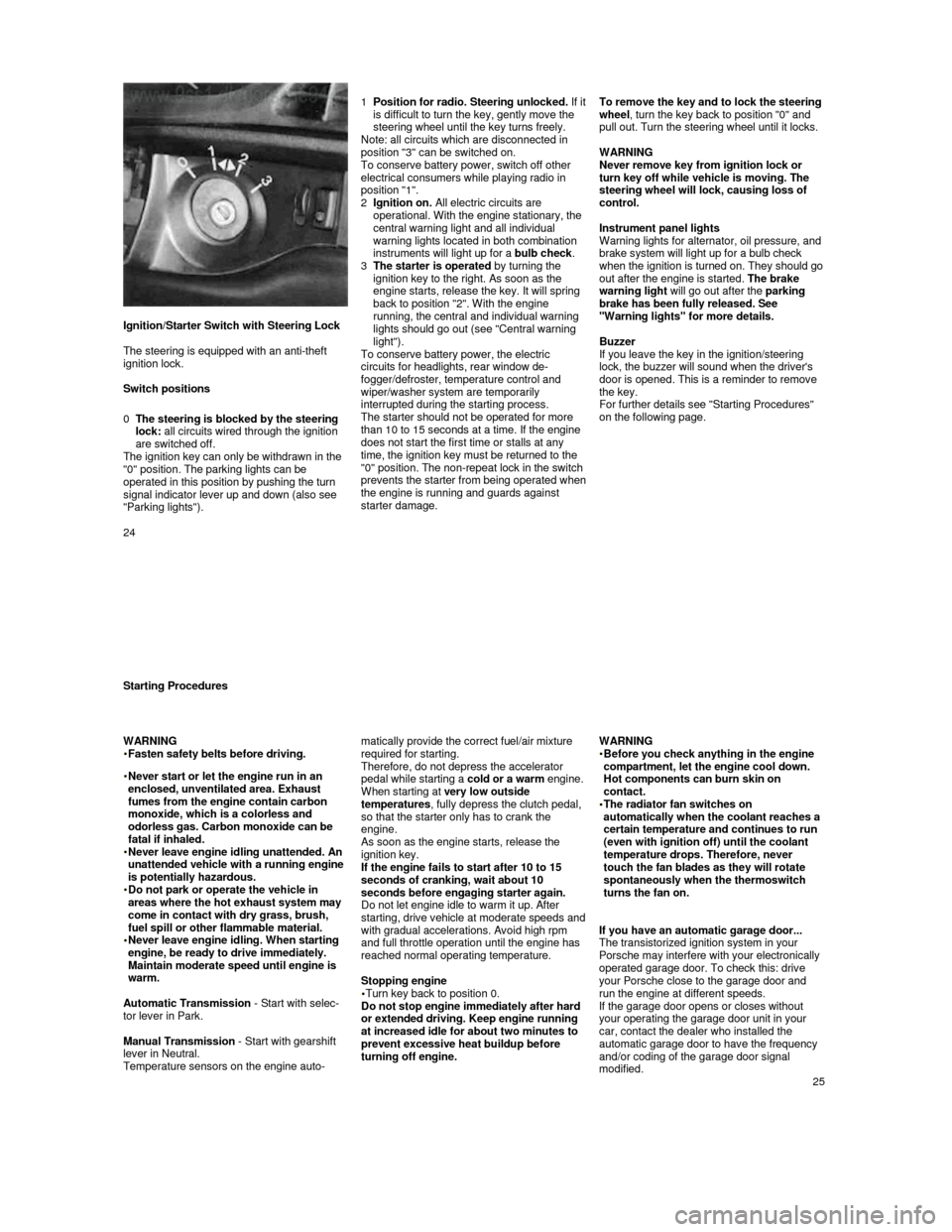
Ignition/Starter Switch with Steering Lock
The steering is equipped with an anti-theft
ignition lock.
Switch positions
0
The steering is blocked by the steering lock: all circuits wired through the ignition
are switched off.
The ignition key can only be withdrawn in the
"0" position. The parking lights can be
operated in this position by pushing the turn
signal indicator lever up and down (also see
"Parking lights").
1 Position for radio. Steering unlocked. If it is difficult to turn the key, gently move the
steering wheel until the key turns freely.
Note: all circuits which are disconnected in
position "3" can be switched on.
To conserve battery power, switch off other
electrical consumers while playing radio in
position "1".
2
Ignition on. All electric circuits are
operational. With the engine stationary, the
central warning light and all individual
warning lights located in both combination
instruments will light up for a bulb check.
3
The starter is operated by turning the
ignition key to the right. As soon as the
engine starts, release the key. It will spring
back to position "2". With the engine
running, the central and individual warning
lights should go out (see "Central warning
light").
To conserve battery power, the electric
circuits for headlights, rear window de-
fogger/defroster, temperature control and
wiper/washer system are temporarily interrupted during the starting process.
The starter should not be operated for more
than 10 to 15 seconds at a time. If the engine
does not start the first time or stalls at any
time, the ignition key must be returned to the
"0" position. The non-repeat lock in the switch
prevents the
starter from being operated when the engine is running and guards against
starter damage.
To remove the key and to lock the steering
wheel
, turn the key back to position "0" and
pull out. Turn the steering wheel until it locks.
WARNING
Never remove key from ignition lock or
turn key off while vehicle is moving. The
steering wheel will lock, causing loss of
control.
Instrument panel lights
Warning lights for alternator, oil pressure, and
brake system will light up for a bulb check
when the ignition is turned on. They should go out after the engine is started. The brake
warning light will go out after the parking
brake has been fully released. See
"Warning lights" for more details.
Buzzer
If you leave the key in the ignition/steering
lock, the buzzer will sound when the driver's
door is opened. This is a reminder to remove
the key.
For further details see "Starting Procedures"
on the following page.
24
Starting Procedures
WARNING
Fasten safety belts before driving.
Never start or let the engine run in an enclosed, unventilated area. Exhaust
fumes from the engine contain carbon
monoxide, which is a colorless and
odorless gas. Carbon monoxide can be
fatal if inhaled.
Never leave engine idling unattended. An unattended vehicle with a running engine
is potentially hazardous.
Do not park or operate the vehicle in areas where the hot exhaust system may
come in contact with dry grass, brush,
fuel spill or other flammable material.
Never leave engine idling. When starting engine, be ready to drive immediately.
Maintain moderate speed until engine is
warm.
Automatic Transmission - Start with selec-
tor lever in Park.
Manual Transmission - Start with gearshift
lever in Neutral.
Temperature sensors on the engine auto- matically provide the correct fuel/air mixture
required for starting.
Therefore, do not depress the accelerator
pedal while starting a cold or a warm engine.
When starting at very low outside
temperatures , fully depress the clutch pedal,
so that the starter only has to crank the
engine.
As soon as the engine starts, release the ignition key.
If the engine fails to start after 10 to 15
seconds of cranking, wait about 10
seconds before engaging starter again.
Do not let engine idle to warm it up. After
starting, drive vehicle at moderate speeds and with gradual accelerations. Avoid high rpm
and full throttle operation until the engine has
reached normal operating temperature.
Stopping engine
Turn key back to position 0.
Do not stop engine immediately after hard
or extended driving. Keep engine running
at increased idle for about two minutes to
prevent excessive heat buildup before
turning off engine.
WARNING
Before you check anything in the engine compartment, let the engine cool down.
Hot components can burn skin on
contact.
The radiator fan switches on automatically when the coolant reaches a
certain temperature and continues to run
(even with ignition off) until the coolant
temperature drops. Therefore, never
touch the fan blades as they will rotate
spontaneously when the thermoswitch
turns the fan on.
If you have an automatic garage door...
The transistorized ignition system in your
Porsche may interfere with your electronically
operated garage door. To check this: drive
your Porsche close to the garage door and
run the engine at different speeds.
If the garage door opens or closes without
your operating the garage door unit in your
car, contact the dealer who installed the
automatic garage door to have the frequency
and/or coding of the garage door signal
modified.
25
Page 16 of 66

Lane changer
To indicate your intention when changing
lanes on the highway, slightly push the turn
signal switch lever up or down to the point of
resistance. The lever will return to the OFF
position when released.
Headlight dimmer
With the light switch at stage 2, high beam is
switched on by pressing the lever towards the
instrument panel, and low beam is switched
on by pulling the lever towards the steering
wheel. When high beams are on, the blue indicator light between the tachometer and the right instrument cluster will light up.
You can flash signal other motorists by
repeatedly pulling and releasing the lever just
up to the point of resistance.
Light Switch
Parking light - 1st position
Headlights -2nd position (with ignition key in
switch position "1").
Tail lights, side marker lights, license plate
and instrument lights are on in both switch
positions.
The retractable headlights open when turning
the switch to the second position.
When you open the door while the lights are
on, the buzzer will sound. It is your reminder
to switch off the lights.
Instrument illumination
The instrument illumination goes on when the
vehicle lights are turned on. Turn the
knob to the left of the light switch for infinitely
variable brightness control.
Turn Signal/Headlight
Dimmer Switch Lever
(ignition on)
Lever up - right turn signal
Lever down - left turn signal
The turn signal lever turns off automatically
when the steering wheel is straightened out after completing a turn.
If a turn signal fails, the indicator light flashes
about twice as fast. The light bulb may have
to be replaced.
Headlight flasher
During daylight, you can flash signal with your
foglights (in lieu of horn) by repeatedly pulling
and releasing the lever just up to the point of
resistance.
Fog lights
- with ignition on
Turn on the fog lights by depressing the rocker switch on the dashboard. A green light in the
switch glows when the fog lights are turned
on.
Parking lights - with ignition off . ... Lever up -
right side parking lights on Lever down - left
side parking lights on
30
Windshield Wiper/Washer Lever
(with intermittent wiper operation)
The windshield wiper/washer switch has se-
ven positions:
1 - Low speed
2 - Normal speed
3 - High speed
4 - Intermittent wiper operation
5 - Windshield washers
6 - Windshield washers and wipers
7 - Headlight washers
The time intervals can be set at the control
element to the right of the ignition lock.
Pulling the lever from its basic position
towards the steering wheel activates the
windshield washer pump in the first stage
(switch position 5) and the windshield wipers
in the second stage (switch position 6).
The electric windshield washer system can be operated by pulling the lever toward the
steering wheel from any wiper position.
When the ignition is switched on, the washer
nozzles are heated, depending on the outdoor temperature. Nevertheless, a commercial windshield anti-freeze solution should be
added to the windshield washer water during
cold weather conditions.
Avoid running the wiper blades over a dry
windshield to p
revent scratching the glass. Spray on washer fluid first. A scratched
windshield will reduce visibility.
Always loosen blades frozen to glass
before operating wipers to prevent damage to wiper motor.
WARNING
Worn or dirty wiper blades will reduce
visibility, making driving hazardous. Clean
blades regularly to remove road film and
carwash wax buildup. Use an alcohol base
cleaning solution, a lint free cloth and wipe lengthwise.
Clean all inside and outside window glass
regularly. In vehicles without Securiflex
windshields use an alcohol base cleaning
solution and wipe dry with a lint free or a
chamois cloth.
In vehicles with Sekuriflex windshields, the plastic coating on the inside of the
windshield must not have gummed labels
put on it or be cleaned using aggressive
agents or dry methods. If very dirty, it can
be cleaned with benzine. Make certain that
the plastic coating is not damaged in
cleaning by hard objects such as jewelry
or wristwatches.
31
Page 22 of 66
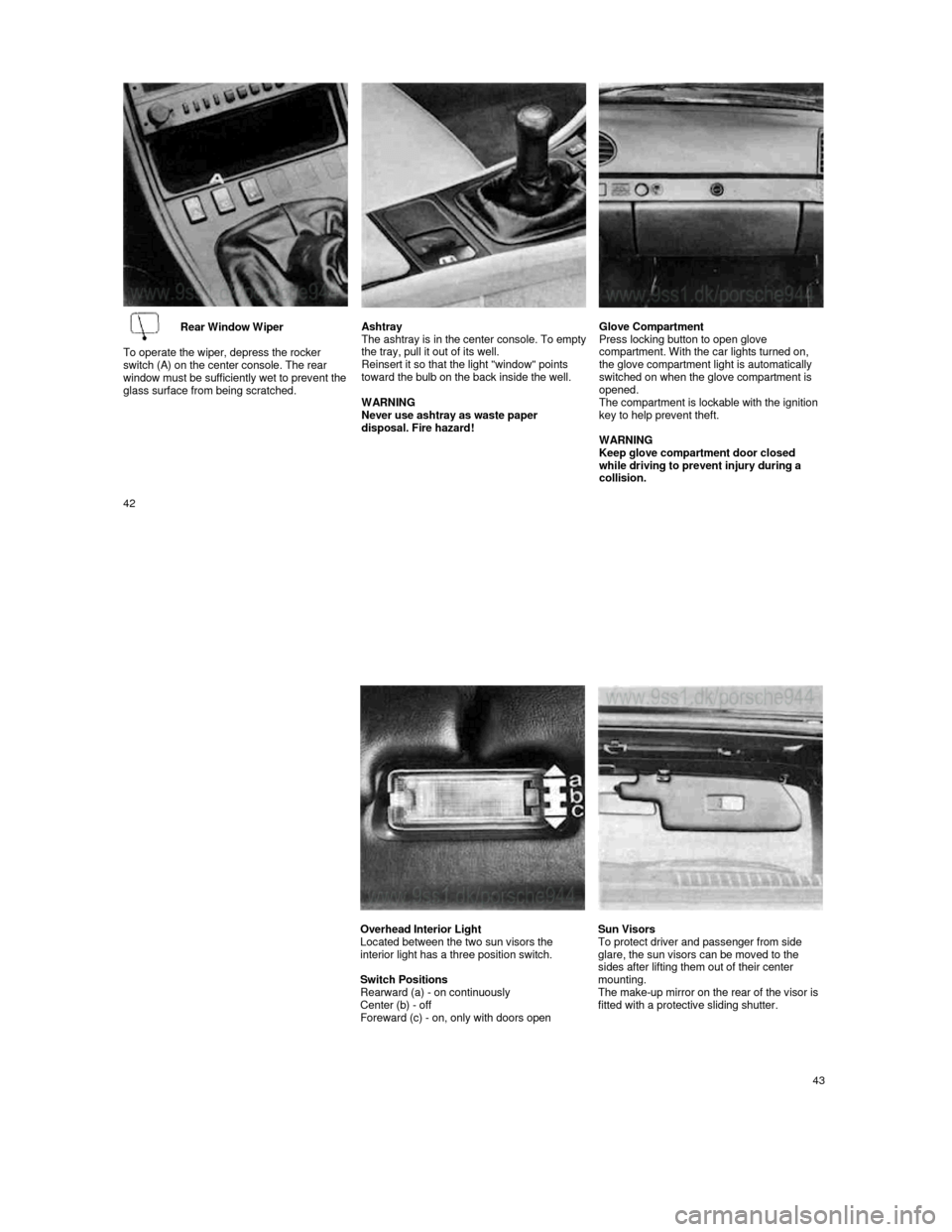
Rear Window Wiper
To operate the wiper, depress the rocker
switch (A) on the center console. The rear
window must be sufficiently wet to prevent the glass surface from being scratched.
Ashtray
The ashtray is in the center console. To empty the tray, pull it out of its well.
Reinsert it so that the light "window" points
toward the bulb on the back inside the well.
WARNING
Never use ashtray as waste paper
disposal. Fire hazard!
Glove Compartment
Press locking button to open glove
compartment. With the car lights turned on,
the glove compartment light is automatically
switched on when the glove compartment is
opened.
The compartment is lockable with the ignition
key to help prevent theft.
WARNING
Keep glove compartment door closed
while driving to prevent injury during a
collision.
42
Overhead Interior Light
Located between the two sun visors the
interior light has a three position switch.
Switch Positions
Rearward (a) - on continuously
Center (b) - off
Foreward (c) - on, only with doors open Sun Visors
To protect driver and passenger from side
glare, the sun visors can be moved to the
sides after lifting them out of their center
mounting.
The make-up mirror on the rear of the visor is
fitted with a protective sliding shutter.
43
Page 32 of 66

Car Care Instructions
Regular and correct care helps to maintain the value of your car and is also a
precondition for the long-life guarantee.
The Porsche paint finish is of a high quality
baked synthetic enamel. The color and
enamel type designation are indicated on the
"paint number sticker". When buying touch-up
paint, always give the paint and the car's
identification numbers to your dealer.
A well-cared for Porsche can look like new 10
years later. It all depends on the amount of
care the owner is willing to give the car.
Your Porsche dealer has a number of car-
care products and can advise you which ones to
use for cleaning the interior and exterior of
your car. Whether you use Porsche
recommended products or other commercially available cleaning agents first make sure of
their correct application.
WARNING
Cleaning agents may be poisonous. Keep
them out of the reach of children.
Observe all caution labels. Always read directions on the container before using any product. Most chemical cleaners are concentrates which require dilution. Do not use gasoline, kerosene, naphtha, nail
polish remover or other volatile cleaning
fluids. They may be toxic, flammable or
hazardous in other ways. Only use spot
removing fluids in well ventilated areas.
Do not wash, wax or dry the vehicle with the
engine running.
Do not clean the underside of chassis,
fenders, wheel covers, etc., without
protecting your hands and arms you may cut
yourself on sharp-edged metal parts.
Moisture and road salt on brakes may affect braking efficiency. Test the brakes after each vehicle washing.
Washing and waxing
The paint on your Porsche is very durable but
must be protected from losing its luster due to
outside influences. Therefore, wash and wax
your Porsche often. The longer the dirt is left
on the paint, the greater the risk of damaging
the glossy finish, either by scratching if the dirt is rubbed into the paint, or simply by the
chemical effect dirt particles have on the paint
surface. Do not wash or wax in direct
sunlight. Do not use hot water. Lukewarm
to cool water is kinder to the paint.
Pamper your Porsche! Wash it by hand! The
mechanical brushes in an Automatic Car
Wash may not reach every angle of the
vehicle, and some tracks may cause
damage to the underbody.
Use plenty of water, a car-wash and wax
solution and a soft sponge or hose brush.
Begin by spaying water over the dry surface to remove all loose dirt before applying the car-wash and wax solution. Use plenty of water to
rinse the vehicle off. Wipe everything dry with
a chamois to avoid water spots.
61
To guard against corrosion from the inside
out, clean drain holes on the bottom of doors,
tail gates, hatches etc., after each washing.
Then wipe dry thoroughly. Also inspect all
weatherstrips to make sure they do not allow water to enter the body panels. Do not aim the water jet directly at door, hatch or rear lid locks. Tape the key holes to prevent water from seeping into the lock cylinders.
Water in lock cylinders should be removed
with compressed air. To prevent locks from freezing in the winter, squirt glycerin or lock
deicer into the lock cylinders.
Do not use any solution that can damage
the body paint.
The underside of the vehicle picks up dirt and
road salts used to keep streets and highways
free of snow and ice. To guard against
corrosion, it is important to remove mud,
debris and road salt from the underside with a
powerful jet of water. Be sure to include the
wheel housings, bumpers, muffler, tailpipe
and brackets. This should be done twice a
year and is best accomplished after the
vehicle has been driven through a heavy rain.
Let engine and exhaust system cool down
before washing.
Waxing is not really needed when you have
used a car-wash and wax solution. If you do
not use a car-wash liquid with wax, apply wax
to preserve the natural shine of the body
paint. To obtain a long lasting finish, apply
hard wax. Wax again if water remains on the
surface in large patches instead of forming
beads and rolling off.
Exterior
Care of the finish
Oils contained in the paint are the most
important ingredients contributing to the
elasticity of the finish. Because these oils
diminish gradually due to weather and similar
causes, they must be replenished through
regular and proper care of the finish. Given
proper care, the original finish will retain its
luster for many years. Ask your dealer for
approved cleaning agents and preservatives.
The use of polishes is recommended only
after it becomes evident that the normal
preservatives no longer accomplish the job.
Dull finishes and plastics
Plastic parts, such as light bulb lenses,
decorative strips, panels, etc., will come clean
during car washing. Should additional
cleaning or spot removal be necessary, use a
soft brush or cloth soaked with a mild
detergent solution. Then rinse thoroughly and
immediately with clear water. Do not use
anything which could mar the plastic or dull
finished surface, such as wax or polish,
abrasive detergents or chemical cleaning
solvents.
Metal trim
Bright or black anodized trim will come clean
when you wash the vehicle. To protect the trim, use car wax.
Touch-up paint
Your dealer has touch-up paint for minor
scratches and stone chips. Scratches should
be touched up soon after they occur, to
prevent corrosion. If corrosion formation
becomes visible, however, a simple touch-up
job will not suffice. The affected surface must
be smoothed with sand paper and covered
with an anti-rust primer, before restoring the
painted finish.
62
Page 48 of 66
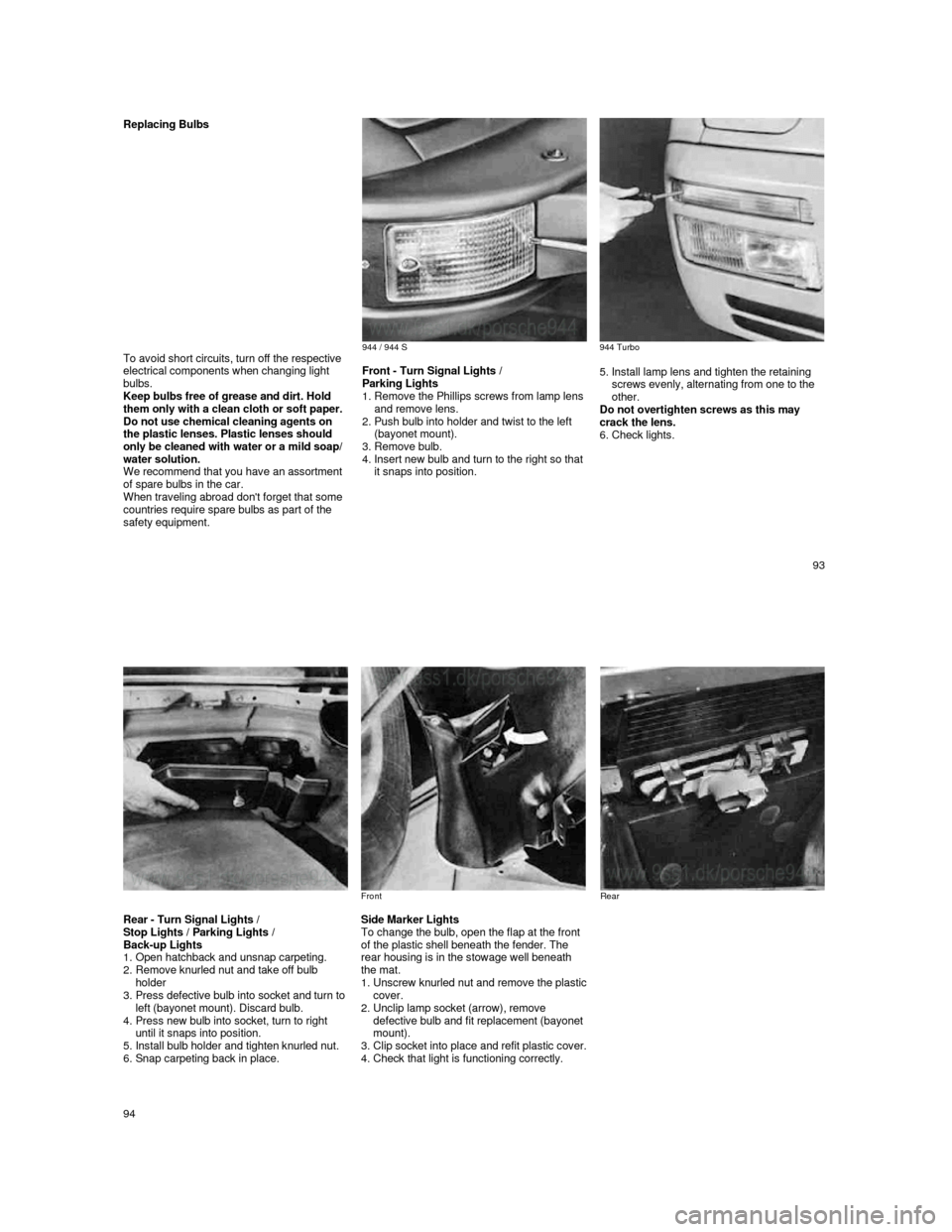
Replacing Bulbs
944 / 944 S
944 Turbo To avoid short circuits, turn off the respective
electrical components when changing light
bulbs.
Keep bulbs free of grease and dirt. Hold
them only with a clean cloth or soft paper.
Do not use chemical cleaning agents on
the plastic lenses. Plastic lenses should
only be cleaned with water or a mild soap/
water solution.
We recommend that you have an assortment
of spare bulbs in the car.
When traveling abroad don't forget that some
countries require spare bulbs as part of the
safety equipment.
Front - Turn Signal Lights /
Parking Lights
1. Remove the Phillips screws from lamp lens
and remove lens.
2.
Push bulb into holder and twist to the left
(bayonet mount).
3.
Remove bulb.
4. Insert new bulb and turn to the right so that
it snaps into position.
5. Install lamp lens and tighten the retaining screws evenly, alternating from one to the
other.
Do not overtighten screws as this may
crack the lens.
6. Check lights.
93
Front
Rear Rear - Turn Signal Lights /
Stop Lights / Parking Lights /
Back-up Lights
1. Open hatchback and unsnap carpeting.
2.
Remove knurled nut and take off bulb
holder
3.
Press defective bulb into socket and turn to
left (bayonet mount). Discard bulb.
4.
Press new bulb into socket, turn to right
until it snaps into position.
5.
Install bulb holder and tighten knurled nut.
6. Snap carpeting back in place.
Side Marker Lights
To change the bulb, open the flap at the front
of the plastic shell beneath the fender. The
rear housing is in the stowage well beneath
the mat.
1.
Unscrew knurled nut and remove the plastic cover.
2. Unclip lamp socket (arrow), remove
defective bulb and fit replacement (bayonet
mount).
3.
Clip socket into place and refit plastic cover. 4. Check that light is functioning correctly.
94
Page 49 of 66
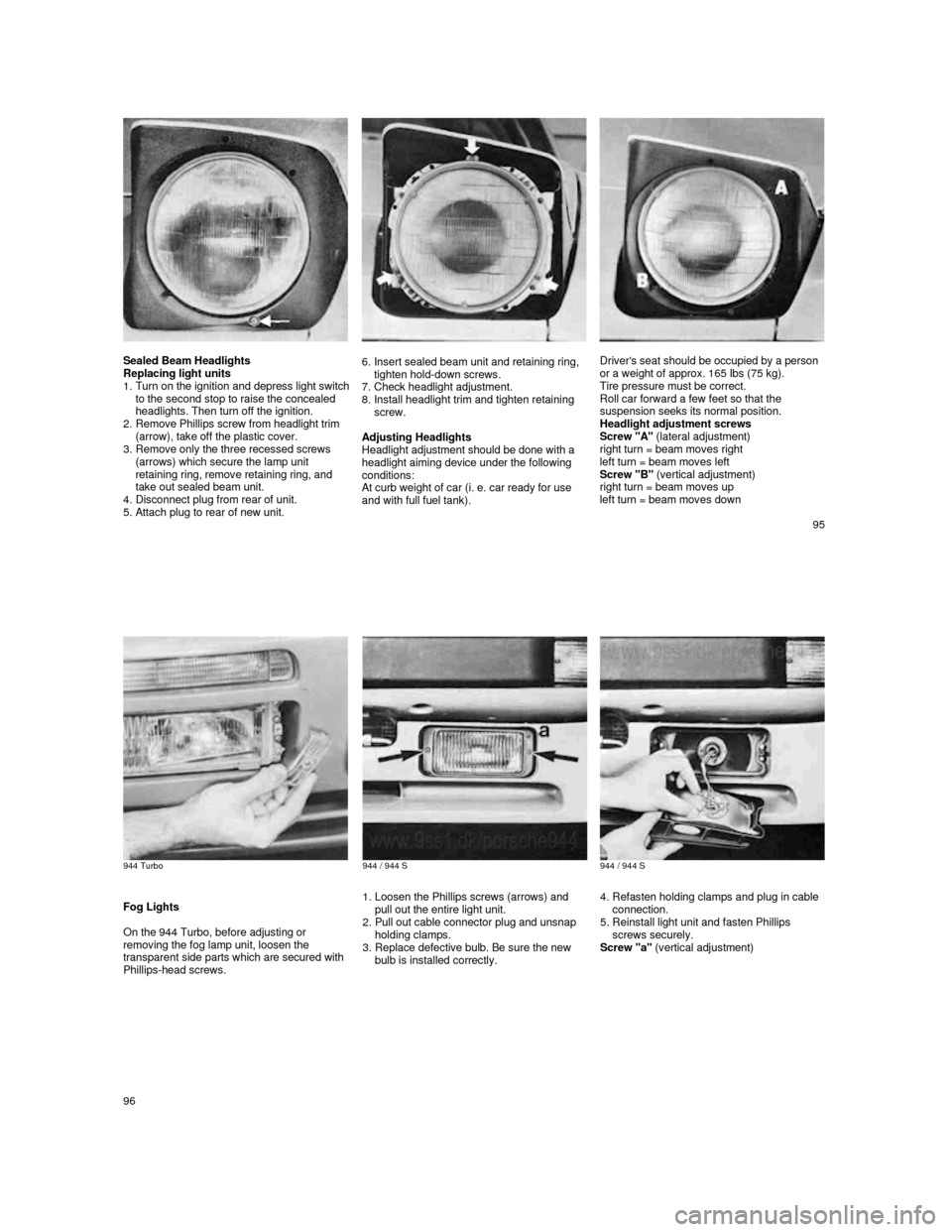
Sealed Beam Headlights
Replacing light units
1.
Turn on the ignition and depress light switch to the second stop to raise the concealed
headlights. Then turn off the ignition.
2.
Remove Phillips screw from headlight trim
(arrow), take off the plastic cover.
3.
Remove only the three recessed screws
(arrows) which secure the lamp unit
retaining ring, remove retaining ring, and
take out sealed beam unit.
4.
Disconnect plug from rear of unit.
5. Attach plug to rear of new unit.
6. Insert sealed beam unit and retaining ring,
tighten hold-down screws.
7.
Check headlight adjustment.
8. Install headlight trim and tighten retaining
screw.
Adjusting Headlights
Headlight adjustment should be done with a
headlight aiming device under the following
conditions:
At curb weight of car (i. e. car ready for use
and with full fuel tank).
Driver's seat should be occupied by a person
or a weight of approx. 165 Ibs (75 kg).
Tire pressure must be correct.
Roll car forward a few feet so that the
suspension seeks its normal position.
Headlight adjustment screws
Screw "A" (lateral adjustment)
right turn = beam moves right
left turn = beam moves left
Screw "B" (vertical adjustment)
right turn = beam moves up
left turn = beam moves down
95
944 Turbo
944 / 944 S
944 / 944 S
Fog Lights
On the 944 Turbo, before adjusting or
removing the fog lamp unit, loosen the
transparent side parts which are secured with
Phillips-head screws.
1. Loosen the Phillips screws (arrows) and
pull out the entire light unit.
2.
Pull out cable connector plug and unsnap
holding clamps.
3.
Replace defective bulb. Be sure the new
bulb is installed correctly.
4. Refasten holding clamps and plug in cable
connection.
5.
Reinstall light unit and fasten Phillips
screws securely.
Screw "a" (vertical adjustment)
96
Page 50 of 66
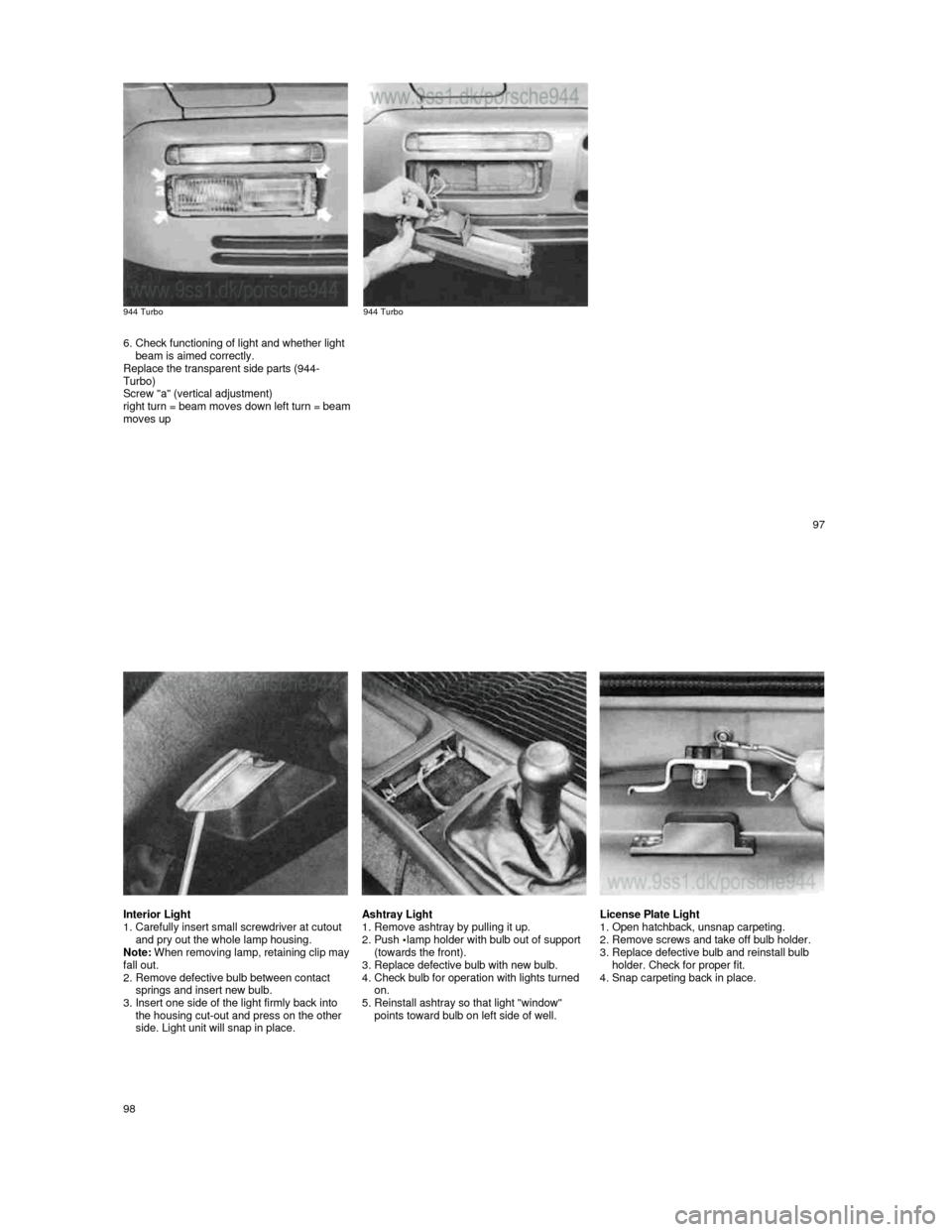
944 Turbo
944 Turbo
6. Check functioning of light and whether light beam is aimed correctly.
Replace the transparent side parts (944-
Turbo)
Screw "a" (vertical adjustment)
right turn = beam moves down left turn = beam moves up
97
Interior Light
1. Carefully insert small screwdriver at cutout and pry out the whole lamp housing.
Note:
When removing lamp, retaining clip may fall out.
2. Remove defective bulb between contact
springs and insert new bulb.
3.
Insert one side of the light firmly back into
the housing cut-out and press on the other
side. Light unit will snap in place.
Ashtray Light
1. Remove ashtray by pulling it up.
2. Push lamp holder with bulb out of support
(towards the front).
3.
Replace defective bulb with new bulb.
4. Check bulb for operation with lights turned
on.
5.
Reinstall ashtray so that light "window"
points toward bulb on left side of well.
License Plate Light
1. Open hatchback, unsnap carpeting.
2. Remove screws and take off bulb holder.
3. Replace defective bulb and reinstall bulb
holder. Check for proper fit.
4.
Snap carpeting back in place.
98